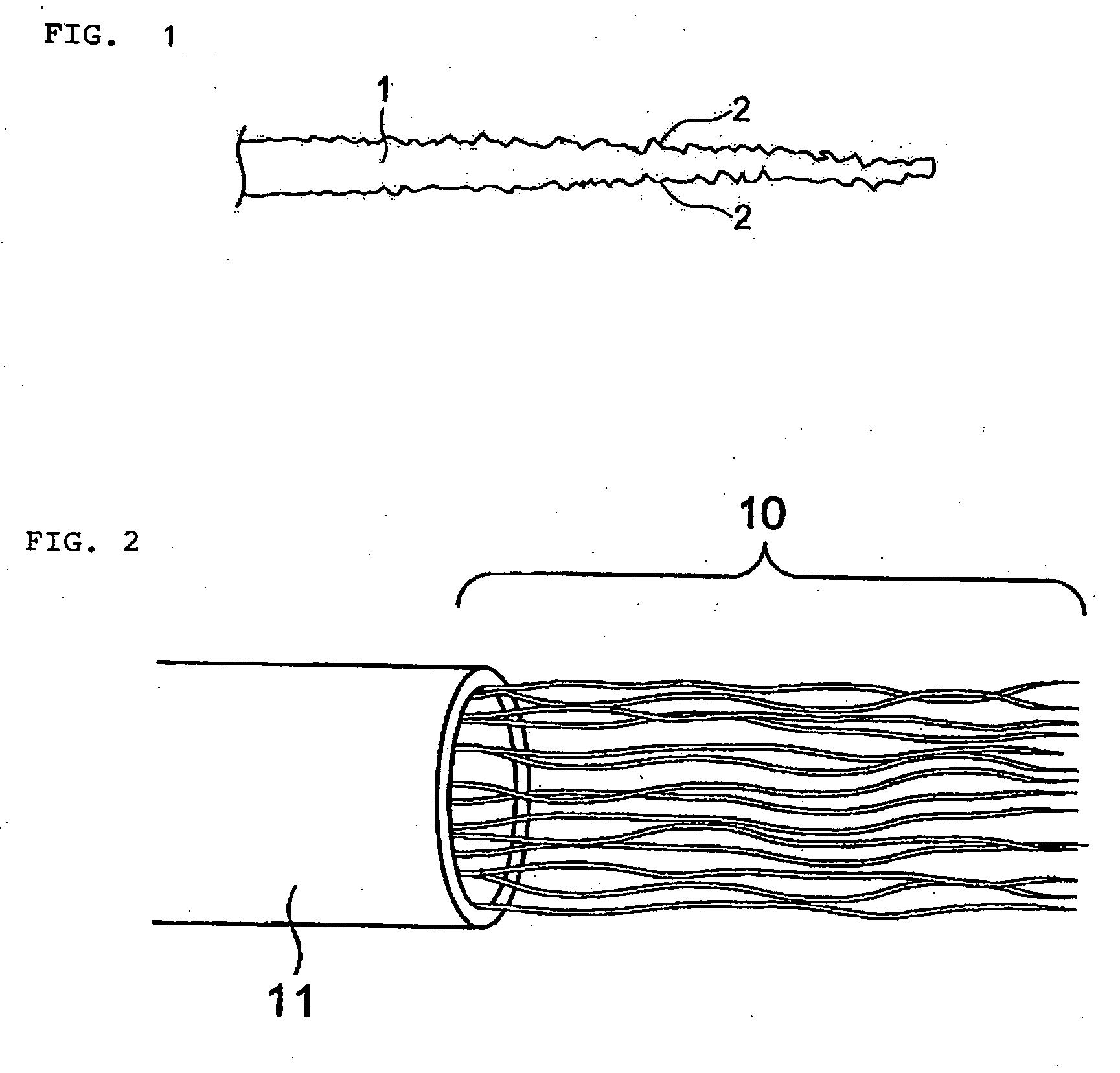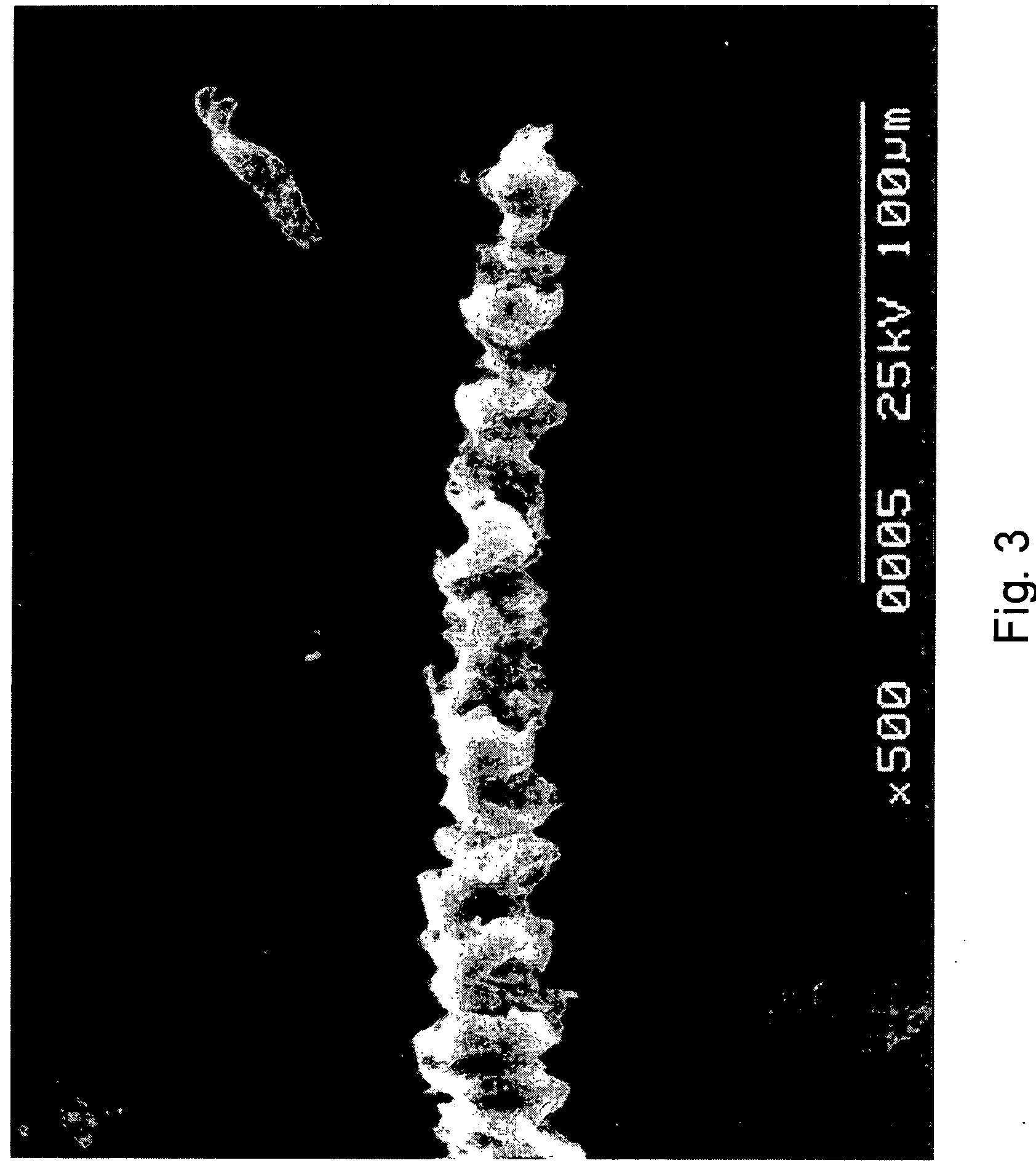Brush bristle material
a brush bristle and material technology, applied in the field of brush bristle material, can solve the problems of reducing the trapping and releasing properties of cosmetics, requiring a higher form factor, and unable to meet the requirements of ptt, and achieves the effect of excellent powder trapping and releasing properties, favorable trapping properties, and effective us
- Summary
- Abstract
- Description
- Claims
- Application Information
AI Technical Summary
Benefits of technology
Problems solved by technology
Method used
Image
Examples
example 1
[0072] Crimps with a length of 45 times the thickness of the fiber and a height of 4 times the thickness of the fiber were added to PTT 80 dtex monofilaments (semi-dull) via the heated gear method to produce a converting bundle of 40 mm in diameter and 50 mm in length (commonly known as “roller”). For the tapering process, a processing solution was prepared by mixing 10 percent by weight of sodium hydroxide, 0.2 percent by weight of DYK-1125 (quaternary ammonium, manufactured by Ipposha Oil Industries) as a hydrolysis accelerator catalyst, 10 percent by weight of Neorate NA-30 (alkyl phosphate, manufactured by Nicca Chemical) as a penetrant, 4 percent by weight of Marpon PS-K (polyhydric alcohol ester, manufactured by Matsumoto Yushi-Seiyaku) as an olygomer solubilizer, and water making up the rest. The aforementioned converting bundle was dipped in this processing solution by 17 mm from the end, and processed for 100 minutes at 120° C., after which the converting bundle was washed,...
example 2
[0076] PTT 100dtex fibers were put together into a converting bundle of 5 cm in diameter and 5 cm in length, and the obtained converting bundle was dipped for 3 cm in a processing solution comprising 16 percent by weight of sodium hydroxide and 0.6 percent by weight of lauryl dimethylbenzyl ammonium chloride, and processed for 70 minutes at 120° C., after which the converting bundle was washed, dried and crimped using a hot roll press. Irregularities of 1 to 25μm were formed on the tapered section at intervals of 5 to 30μm.
2>
[0077] A cosmetic brush using the hair material of the comparative example was brushed against powdery foundation three times. As a result, 0.001 g of powdery foundation attached to the brush. With a cosmetic brush using the hair material according to an embodiment of the present invention, however, the amount of powdery foundation picked up by the brush was 0.002 g. When the cosmetic brush using the conventional brush material was dipped into a cosmetic lotion...
example 3
[0078] Using the hot roll method, crimps with a crimp length of 40 times the thickness of the fiber and a crimp height of 3 times the thickness of the fiber were added to PTT 200 dtex monofilaments to produce a converging bundle of 4 cm in diameter and 3 cm in length.
[0079] A processing solution was prepared by mixing 10 percent by weight of sodium hydroxide, 0.4 percent by weight of DYK-1125 (quaternary ammonium) as a hydrolysis accelerator catalyst, 8 percent by weight of Neorate NA-30 as a penetrant, 5 percent by weight of Marpon PS-K as an olygomer solubilizer, and water making up the rest. The aforementioned converging bundle was tied at the center, and the entire converging bundle was dipped in this processing solution and processed for 100 minutes at 130° C. to provide a tapering processing whereby irregularities were formed on both ends of the converging bundle simultaneously. Thereafter, the converging bundle was neutralized, washed and dried to produce tapered brush brist...
PUM
| Property | Measurement | Unit |
|---|---|---|
| length | aaaaa | aaaaa |
| length | aaaaa | aaaaa |
| length | aaaaa | aaaaa |
Abstract
Description
Claims
Application Information
 Login to View More
Login to View More - R&D
- Intellectual Property
- Life Sciences
- Materials
- Tech Scout
- Unparalleled Data Quality
- Higher Quality Content
- 60% Fewer Hallucinations
Browse by: Latest US Patents, China's latest patents, Technical Efficacy Thesaurus, Application Domain, Technology Topic, Popular Technical Reports.
© 2025 PatSnap. All rights reserved.Legal|Privacy policy|Modern Slavery Act Transparency Statement|Sitemap|About US| Contact US: help@patsnap.com



